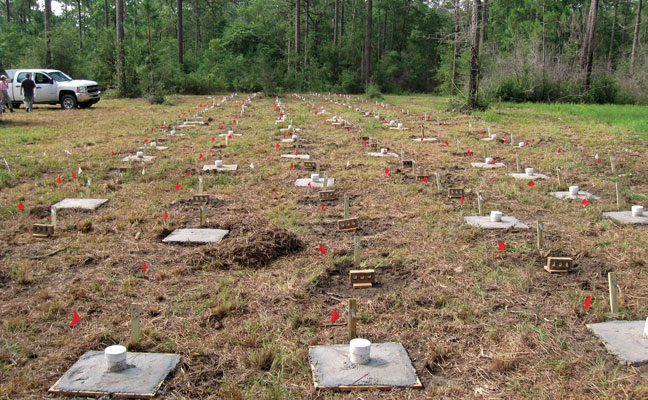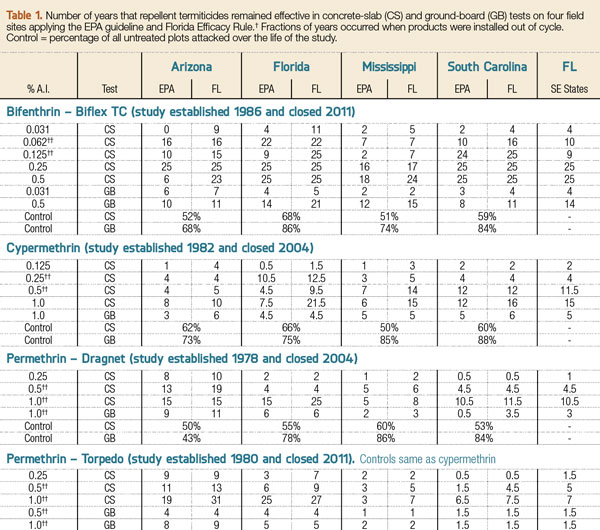
Figure 1. Completed ground board (bare soil with board and brick) and concrete slab (slab with PVC pipe) test at the Harrison Experimental Forest. Cement slab plots with no PVC pipe are soil sampling plots. PHOTO: USDA-USFS
As most pest management professionals (PMPs) know, soil termiticides are required to have specific efficacy data for federal registration by the U.S. Environmental Protection Agency (EPA). The data collected annually by the U.S. Department of Agriculture’s (USDA’s) Forest Service Forest Products Laboratory (FPL), Durability and Wood Protection research work unit (RWU 4723) serves to fulfill this need.
The FPL-RWU team installs and evaluates wooden test pieces on plots of soil treated with candidate termiticide products. Data from these studies are used in the registration process for overall efficacy and accepted application concentrations for the product label. This annual report is generated to show the current study data for soil termiticide products that have reached federal registration. The data provided are limited to label-approved rates of application for these products.
Because the U.S. Forest Service (USFS) observes some plot locations late in the calendar year, this article is reporting on the previous year’s data. For the 2020 report, please see the February 2021 issue of Pest Management Professional (PMP), starting on p. 20.
These data studies have been ongoing since their inception in 1938 for the military on plots located in the Harrison Experimental Forest (HEF) near Gulfport, Miss. This location has remained a constant and active part of this program, whereas a number of the other locations has expanded and contracted over the years. At press time, the following sites are in current use: the Chipola Experimental Forest in northwestern Florida, the HEF in southern Mississippi, and the Calhoun Experimental Forest in western South Carolina. Because only native subterranean termite species belonging to the genus Reticulitermes occur at these sites, our test data only applies to members of this termite genus.
CURRENT PROGRAM STATUS
In 2021, no new products were installed at the USFS termiticide testing sites. Two ongoing candidate termiticides were evaluated, and one study was closed. During 2022, we were asked to perform both the laboratory and field tests with one new candidate compound.
While the lab study will start soon, the field installations will not begin until February 2023. Due to extensive and backlogged hurricane damage, further clearing of our location on the Chipola Experimental Forest will be required this fall before new product installation can occur.
However, when it does happen, this will be the first new candidate product installed since 2017. The tables included in this report provide data for current federally labeled termiticides in the United States. Manufacturers of these candidate products can withdraw products from testing for any reason. It is our policy to not report on products that do not obtain federal registration; therefore, no withdrawn products or EPA-rejected products appear in the data tables of this report. This prevents confusion and possible off-label use of agricultural products that contain the same active ingredient.

† EPA: years with no penetration through treated soil in any plot.
FL: years with no annual damage more severe than ASTM 9 to blocks or boards on 90% or more of the plots per site (each annual evaluation stands alone, not cumulative).
FL SE States: years with no annual damage more severe than ASTM 9 to blocks or boards on 90% or more of the plots across the southeastern sites (damage ratings are annual, not cumulative).
†† Registered label rates.
OVERALL METHODS
The USFS termiticide testing program provides data as an unbiased third-party on the efficacy of candidate termiticides in cooperation with the tested product’s manufacturer. Collected efficacy data is used for eventual inclusion in a registration packet submitted to the EPA seeking federal registration. Tests are initiated when a potential cooperator brings a candidate product to our unit with the chemical concentration series they are interested in examining.
Cooperator personnel can observe and assist to a limited extent with the study. General assistance, such as digging holes or clearing trees from a plot area, is acceptable. Help from cooperators with mixing product, treating plots, and determining wood block damage (reading), though, is not allowed. The RWU 4723 personnel who mix and apply candidate chemicals have current commercial pesticide applicator certificates and many years of experience with the test protocol.
The USFS protocol offered includes installation and reading of plots using the ground board, concrete slab and stake methods, as well as residual pesticide soil sample collection. Both the ground board and concrete slab methods are tests for soil barrier efficacy; the stake method is a slightly different barrier test for wood embedded in treated soil and has not been requested for decades.
The three methods are identical to those required by the EPA Office of Poisons, Pesticides and Toxic Substances’ (OPPTS’) 810.3600 document. This document requires five years of efficacy data for candidate termiticides. In total, from product installation to completion, the studies take six years to complete. USFS provides product manufacturers with updates on their products’ performance annually. The EPA, as well as state regulatory agencies (once the product obtains federal registration) are free to contact the USFS regarding the data or methods used to obtain them.
TEST METHODS
The EPA Product Performance Test Guideline – OPPTS 810.3600 specifies two protocols for testing these products: the ground board test and the modified ground board (or concrete slab) test. Ten replicates of each concentration, including water-only controls, are installed for each candidate termiticide in each of the three national field sites.
The methods are described in the annual termiticide report each year (PMP, May 2017 and all earlier USFS annual termiticide reports). Because no procedural changes have been made, the language used to describe them remains relatively constant.
The ground board test employs a 24-by-24-inch area that is cleared of debris, roots and rocks. Then a 17-by-17-inch area is treated with the candidate termiticide. After drying, a 6-by-6-inch square pine sapwood board is centered on the exposed termiticide-treated soil, and held in place with a brick.
The concrete slab test is very similar. In this test, a 24-by-24-inch area is cleared and prepped as described above. A 17-by-17-inch area is treated as in the ground-board test. After treatment, the soil is covered by a polyethylene vapor barrier, and a 21-by-21-inch concrete slab is poured around a 4-inch diameter polyvinyl chloride (PVC) pipe, which is placed at the center of the square.
Once the concrete has set, the vapor barrier is cut out and removed from the bottom interior of the PVC pipe, and a 3.5-by-2.5-by-1.5-inch rectangular pine sapwood block is placed on the treated soil at the bottom of the pipe. To prevent weathering of the treated soil, a PVC cap is placed on the pipe. Completed plots form a grid in the forest (see Figure 1).
Mixed solutions of candidate termiticides are applied to the soil at the pre-construction rate of 1 gallon per 10 square feet in both test types. The wood placed in each plot is annually evaluated for termite damage using a simple scale called the Gulfport scale (see box, p. 50), and the presence or absence of live termites infesting test blocks or boards is noted.
SOIL SAMPLING
In 1998, the testing program began adding extra ground board and concrete slab plots for pesticide residue analysis at each concentration level of a newly installed product. Soil sample cores measuring 1 inch in diameter and 4 inches in length are collected both after initial installation and on each subsequent year of the study. After the soil core is taken, a small PVC spacer is placed in the spot the sample was taken to prevent the same place from being sampled again at a later date.
The ground board and concrete slab plots designated for soil sample collection have no wood blocks in the plots, and are not read for termite feeding (see Figure 1). The collected soil samples are shipped to the product manufacturer for residue analysis of their product. Manufacturers can choose whether they want to analyze the samples. Results pertaining to soil sample residue analysis are not shared with the USFS. For this reason, none of the soil sample data appear in the annual termiticide report.
PLANNED CHANGES TO THE PROGRAM
Starting in 2023, we are shifting the timing of plot reading and installation occurring at the HEF (Mississippi) test site to April. This is due to better weather conditions and the loss of access to the Arizona study area (the Santa Rita Experimental Range), which in the past was read in April.
Because April is much cooler than June (the HEF’s current time slot), the change is a welcome relief for labor reasons. And because termite feeding on the blocks and boards are essentially measured annually, the actual date of reading does not matter after the first shift in reading. Activity (finding termites on blocks or boards) might be slightly different between spring and summer in southern Mississippi, but regulatory decisions are made only on the block/board feeding rating.
In addition, longtime report co-author Dr. Juliet Tang will retire from the USFS in December. The research work unit wishes her the best in her next chapter, and hopes to be able to fill her position by 2024.
PERFORMANCE STANDARDS
Previous annual termiticide reports by the USFS (PMP, 2016 and earlier) have reported a single standard for federal registration under the EPA, under which each state can create its own standard. The lead agency for structural pest control in each state makes decisions regarding the use or sale of a product via either a state-specific regulatory standard (such as the Florida Termiticide Efficacy Rule, 5e-2.0311, FAC), or their own judgment of the USFS efficacy data on the product. Many state lead agencies choose to make these decisions collectively through the Association of Structural Pest Control Regulatory Officials (ASPCRO).
For the USFS annual termiticide reports, the data in Tables 1 and 2 are presented for each site individually, as evaluated using the EPA guidelines, and as an example of a state standard, the Florida Rule (individually by site and collectively across all southeastern sites). Discussions of the differences between the two standards have been covered in many of the past annual reports (PMP, April 2016 and earlier).
LATEST TEST RESULTS
Data collected through 2021 for all repellent (Table 1) and non-repellent (Table 2) termiticides are available through the corresponding links. No new products entered the market in 2021, and all currently registered soil-applied termiticide products have had their studies closed at the request of their respective manufacturers. Thus, no new products whose data can be revealed are presented in this year’s report. The tables and data in this report are the same as the 2015 report (PMP, May 2015). All recently collected data are for as of yet unregistered products that remain confidential until after registration.
CONCLUSIONS
The USDA-USFS has provided unbiased candidate termiticide efficacy data for federal needs (military or regulatory) since 1938. The termiticide testing program has provided performance data to the EPA for all federally registered products. These data also are provided to pest management professionals and homeowners via this report. We hope this information enables the public to make informed decisions regarding the protection of wood in service from termite attack, and assists pest management companies in making decisions about which termiticide products to offer their customers.
DR. SHELTON is a supervisory research entomologist; BELL is a biological science technician; DR. TANG is a research forest products technologist; and DR. MANKOWSKI is a research entomologist. All four authors are with the USDA-USFS Forest Products Laboratory, Durability and Wood Protection Research Unit, located in Starkville, Miss.
Leave A Comment